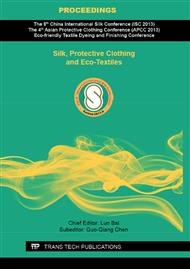[1]
B. K Staley and K.D. Irvine. Hippo signaling in Drosophila: recent advances and insights. Dev Dyn, 241(1): 3–15 (2012).
DOI: 10.1002/dvdy.22723
Google Scholar
[2]
J. Dong, G. Feldmann, J. Huang, S. Wu, N. Zhang, S.A. Comerford, M.F. Gayyed, R.A. Anders, A. Maitra and D. Pan. Elucidation of a Universal Size-Control Mechanism in Drosophila and Mammals. Cell, 130: 1120–1133 (2007).
DOI: 10.1016/j.cell.2007.07.019
Google Scholar
[3]
K. Schlegelmilch, M. Mohseni, O. Kirak, J. Pruszak, J.R. Rodriguez, D. Zhou, B.T. Kreger, V. Vasioukhin, J. Avruch, T.R. Brummelkamp and F.D. Camargo. Yap1 Acts Downstream of a-Catenin to Control Epidermal Proliferation. Cell, 144: 782–795 (2011).
DOI: 10.1016/j.cell.2011.02.031
Google Scholar
[4]
F.A. Grusche, H.E. Richardson and K.F. Harvey. Upstream Regulation of the Hippo Size Control Pathway. Current Biology, 20: 574–582 (2010).
DOI: 10.1016/j.cub.2010.05.023
Google Scholar
[5]
M. Yin and L. Zhang. Hippo signaling: A hub of growth control, tumor suppression and pluripotency maintenance. Genetics and Genomics, 38: 471-481 (2011).
DOI: 10.1016/j.jgg.2011.09.009
Google Scholar
[6]
B. Zhao, L. Li, Q. Lei and K. Guan. The Hippo–YAP pathway in organ size control and tumorigenesis: an updated version. Gene and Development, 24: 862–874 (2010).
DOI: 10.1101/gad.1909210
Google Scholar
[7]
K.F. Harvey, C.M. Pfleger and I.K. Hariharan. The Drosophila Mst ortholog, hippo, restricts growth and cell proliferation and promotes apoptosis. Cell 114: 457–467(2003).
DOI: 10.1016/s0092-8674(03)00557-9
Google Scholar
[8]
S. Wu, J. Huang, J. Dong and D. Pan. Hippo encodes a Ste-20 family protein kinase that restricts cell proliferation and promotes apoptosis in conjunction with salvador and warts. Cell 114: 445–456 (2003).
DOI: 10.1016/s0092-8674(03)00549-x
Google Scholar
[9]
B. Zhao, K. Tumaneng, K.L. Guan. The Hippo pathway in organ size control, tissue regeneration and stem cell self-renewal. Nat. Cell Biol. 13: 877–883 (2011).
DOI: 10.1038/ncb2303
Google Scholar
[10]
B. Zhao, X. Wei, W. Li, R.S. Udan, Q. Yang, J. Kim, J. Xie, T. Ikenoue, J. Yu, L. Li, P. Zheng, K. Ye, A. Chinnaiyan, G. Halder, Z.C. Lai and K.L. Guan. Inactivation of YAP oncoprotein by the Hippo pathway is involved in cell contact inhibition and tissue growth control. Genes Dev. 21: 2747–2761 (2007).
DOI: 10.1101/gad.1602907
Google Scholar
[11]
M. Sudol and K.F. Harvey. Modularity in the Hippo signaling pathway. Trends Biochem. Sci. 35: 627–633 (2010).
DOI: 10.1016/j.tibs.2010.05.010
Google Scholar
[12]
F. Hamaratoglu, K. Gajewski, L. Sansores-Garcia, C. Morrison, C. Tao and G. Halder. The Hippo tumor-suppressor pathway regulates apical-domain size in parallel to tissue growth. Cell Sci. 122: 2351–2359 (2009).
DOI: 10.1242/jcs.046482
Google Scholar
[13]
S.E. Hiemer and X. Varelas. Stem cell regulation by the Hippo pathway. Biochim. Biophys. Acta, 2012. 07. 005(2012).
Google Scholar
[14]
B. Zhao, Q. Lei and K. Guan. The Hippo-YAP pathway: new connections between regulation of organ size and cancer. Cell Biol, 20: 638-646 (2008).
DOI: 10.1016/j.ceb.2008.10.001
Google Scholar
[15]
D. Pan. Hippo signaling in organ size control. Genes Dev, 21: 886–897 (2007).
DOI: 10.1101/gad.1536007
Google Scholar
[16]
I. Lian, J. Kim, H. Okazawa, J. Zhao, B. Zhao, J. Yu, A. Chinnaiyan, M.A. Israel, L.S. Goldstein, R. Abujarour, S. Ding and K.L. Guan. The role of YAP transcription coactivator in regulating stem cell self-renewal and differentiation. Genes Dev. 24: 1106–1118 (2010).
DOI: 10.1101/gad.1903310
Google Scholar
[17]
R. Yagi, L.F. Chen, K. Shigesada, Y. Murakami and Y. Ito. A WW domain-containing yes-associated protein (YAP) is a novel transcriptional co-activator. EMBO J. 18: 2551–2562 (1999).
DOI: 10.1093/emboj/18.9.2551
Google Scholar
[18]
A. Gise, Z. Lin, K. Schlegelmilch, L.B. Honor, G.M. Pan, J.N. Buck, Q. Ma, T. Ishiwata, B. Zhou, F.D. Camargo and W.T. Pu. YAP1, the nuclear target of Hippo signaling, stimulates heart growth through cardiomyocyte proliferation but not hypertrophy. Proc. Natl. Acad. Sci. U. S. A. 109: 2394–2399 (2012).
DOI: 10.1073/pnas.1116136109
Google Scholar
[19]
F.D. Camargo, S. Gokhale, J.B. Johnnidis, D. Fu, G.W. Bell, R. Jaenisch and T.R. Brummelkamp. YAP1 increases organ size and expands undifferentiated progenitor cells. Curr. Biol. 17: 2054–2060 (2007).
DOI: 10.1016/j.cub.2007.10.039
Google Scholar
[20]
J. Cai, N. Zhang, Y. Zheng, R.F. de Wilde, A. Maitra and D. Pan. The Hippo signaling pathway restricts the oncogenic potential of an intestinal regeneration program. Genes Dev. 24: 2383–2388(2010).
DOI: 10.1101/gad.1978810
Google Scholar
[21]
R.L. Shaw, A. Kohlmaier, C. Polesello, C. Veelken, B.A. Edgar and N. Tapon. The Hippo pathway regulates intestinal stem cell proliferation during Drosophila adult midgut regeneration. Development 137: 4147–4158 (2010).
DOI: 10.1242/dev.052506
Google Scholar
[22]
F. Ren, B. Wang, T. Yue, E.Y. Yun, Y.T. Ip and J. Jiang. Hippo signaling regulates Drosophila intestine stem cell proliferation through multiple pathways. Proc. Natl. Acad. Sci. U. S. A. 107: 21064–21069(2010).
DOI: 10.1073/pnas.1012759107
Google Scholar


